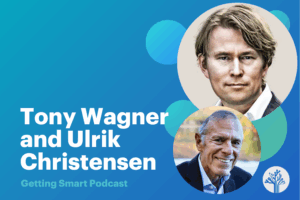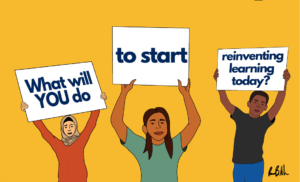Change is Difficult, But It is Possible

By: Jason McKenna
My first day in Rio de Janeiro was a busy one. After a lengthy flight, I was privileged to meet with members of the Department of Education in Rio, allowing me to get reacquainted with a city and a system I was no stranger to, but hardly fully understood.
Meetings eventually took me to the Department’s main office, and when I walked in, I was greeted by this picture of Paulo Friere:

It struck me as especially poignant after my visits with government officials, school leaders, and teachers throughout Brazil seemed to echo a similar sentiment. The belief in change existed, but not without the acknowledgment of how deep and systemic the change must be. After all, the need for change in Brazil infiltrated much of its organizational structures – politics, economics and, of course, education. Brazil needed to change, and so did the school system within it.
This view is hardly unique to Brazil. Everywhere, industries of all kinds fight the inertia inherent to systemic change. “If we could just find the right approach to the right problems…”
You would be hard-pressed to find anyone in Brazil willing to defend the status quo as a viable option. Currently in Brazil, most schools want to prepare students to compete in an increasingly tech-based world, but the school programs still do not have any emphasis on STEM, technology is not embedded into the curriculum in a meaningful way, and the technological infrastructure of many schools needs considerable improvement. This is all in addition to a most pressing need – a need to invest in teacher training and professional development. While it’s tough to say whether throwing laptops at the 21st-century economy problem would elicit similar local failures as we’ve seen in other countries’ pasts, I’m not convinced that an approach grounded in the humility that so many failed grand gestures lack, wouldn’t be worth a try (no matter what the locally-identified problems). And so I began to reflect on all I’d read and researched on education, as well as my varied experiences in my own hometown–Pittsburgh, a rather unique point of reference in and of itself, as the city’s undergone its own renaissance exemplifying the benefits of action.
As featured in Inc. magazine, the economic resurgence of Pittsburgh is receiving widespread attention and an attitude of endearment towards all the radical change:
The old factories and warehouses dotting the Allegheny River make up Robotics Row, where Edge Case Research–which, among other things, tests self-driving-car software–works out of 19th-century stables. Boutiques and craft breweries have taken over Lawrenceville’s vacant storefronts in this once blue-collar neighborhood. Grab a coffee at Caffè d’Amore in Upper Lawrenceville on your way to RE2 Robotics, a robotic arm manufacturer. Farther south, Toll Gate Revival sells reclaimed industrial objects near Uber’s Advanced Technologies. With more than 500 employees, Google’s presence in Bakery Square, site of a former Nabisco factory, looms large in East Liberty. Startup accelerators AlphaLab and AlphaLab Gear reside here, as does language-learning app Duolingo, which recently relocated from the Shadyside neighborhood.
I continued reflecting on Pittsburgh’s evolution as I left Rio for Bett Latin America, in Sao Paulo. There I heard school leaders and government officials refer to the 21st-century creative economy in Brazil, and I began to wonder if all I had witnessed and now enjoy about Pittsburgh is very close to what Brazil is aspiring to; that 21st century creative economy that Brazil not only wants to prepare their students for, but the economic vision they want to flourish within their own cities. The link between what has happened in Pittsburgh and what is being attempted in Brazil reminded me about the universality of social and education issues, and the very real nuances that are created by more variables than we can often imagine.
The complexity of nuance and variability accounts for much of the difficulty I think Friere is referencing in his poignant quote about change. But, I knew first hand, the city of Pittsburgh offers proof that lofty visions are achievable. Using education to eradicate impediments to growth is an effective means, imagine the difficulty of being able to attract, retain and develop talent without a strong base of education in a region, and I believe the most effective ways to improve student achievement are to: have the students engage in curriculum that is focused on teaching big ideas and create an expectation that all teachers continue to improve their pedagogy.
The importance of these solutions can’t be underestimated, because oftentimes big challenges in education receive fancy names – some insightful and some distracting – and are often met with big (and very expensive) solutions. Solutions which, have a scope that often includes much more than a humble focus on consistently developing curriculum and the teachers that facilitate it. Yet time and again, we’re reminded that initiatives such as providing all students with $100 laptops didn’t save the new world of innovation…so what will? What will actually help prepare the students of Brazil for the very real economic challenges they will inevitably face?
A well-intentioned approach – that doesn’t at all solve the problem – is the all too frustrating attempt to stay ahead of the ever-shifting development of technology by simply amassing content. Staying abreast of leading-edge trends is great, but if that translates into simply throwing together information and calling it valuable just because it’s novel, we hinder any real progress before we even begin.
Yet, while it hardly justifies the loss of time, learning that straight content is indeed not automatically a meaningful curriculum, may be one of the finest examples of the value that can be found in failure.
Much like the world of education need not another reform that just adds more hassle and headaches for teachers, school and government leaders need to make very clear that what their students need is not blanket solutions or an onslaught of modern content, but instead curriculum. What, if not curriculum, brings together this new frontier of STEM content, the unique, engaging and unfamiliar?
Let’s imagine this STEM content in a different way. If we imagine the chunks of content promising to deliver 21st-century skills as individual people, all with unique strengths, personalities and challenges, we can then try to visualize why combining them into a functioning unit is not so simple – throwing them all into a room doesn’t make them a family. In this same way, no matter how unique, interesting and inspiring the individual lessons and activities designed to solve for STEM success are, a haphazard collection of lessons and activities does not immediately translate to meaningful curriculum.
To carry this analogy further; among many other things, a family provides structure, support, guidance, feedback and opportunities for growth. A curriculum does the same. This point must be emphasized because of the result that Brazil is looking for from their students is for them to become the creators, innovators and problem-solvers of tomorrow, then that is going to require them to gain and access deep reservoirs of knowledge in different domains, understand how ideas within those domains are related, and then be able to organize that information across those domains. The kind of structure, guidance and feedback needed to accomplish these worthy and ambitious goals is not possible without great curriculum.
This may make curriculum sound like our closest bet to a panacea, but a dose of realism reminds us that even developing grounded, “big idea” curriculum for the future is fraught with difficulties. After all, predicting the future is hard; and it seems to be only getting harder. Predicting the tools that students will need to be proficient in unknown working environments, even only five years from now, is incredibly hard. The speed of technology adoption is increasing, and it’s difficult to deny how this break-neck pace results in new and exciting features becoming ordinary and boring very quickly. This in turn creates a pressure so pervasive, even many tech companies themselves feel pushed to constantly create new features and tools, or risk flailing in the face of inevitable market disruption. As a result, that piece of technology or programming language that seems uncompromisingly required for students to master today, quickly becomes obsolete tomorrow. The important thing then, is a curriculum that is aligned to big ideas that can be applied to both the technology of today, and tomorrow.
I’ve been lucky enough to witness the educational journey in Brazil twice in the past six months. Being able to honestly observe and assess the current reality of education in other places is important, especially when when it allows us to see that their challenges are not altogether unique nor insurmountable, and that ours aren’t either. And, the first step does not have to be a leap. Continuous acknowledgment of the power of a robust curriculum that enables teachers to have meaningful interactions with their students will lead to change, no matter how fast and varied our technological terrain becomes.
For more, see:
- Global STEM Alliance Engages Youth and Mentors In Grand Challenges
- Integrating the Engineering Design Process and Challenge-Based Learning in STEM
- Addressing the Growing Need for Data Science Education
Jason McKenna is the Director of Educational Strategy at Robomatter. Follow him on Twitter: @McKennaJ72
Stay in-the-know with all things edtech and innovations in learning by signing up to receive the weekly Smart Update.







0 Comments
Leave a Comment
Your email address will not be published. All fields are required.